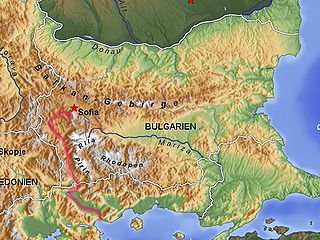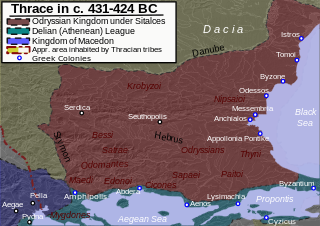
Sérres is a city in Macedonia, Greece, capital of the Serres regional unit and second largest city in the region of Central Macedonia, after Thessaloniki.
The Bithyni were a Thracian tribe who, along with the Thyni, migrated to Anatolia. Herodotus, Xenophon and Strabo all assert that the Bithyni and Thyni settled together in what would be known as Bithynia and Thynia. According to Herodotus, the Bithynian Thracians originally lived along the Strymon river, and were known as Strymonians.

The Struma or Strymónas is a river in Bulgaria and Greece. Its ancient name was Strymṓn. Its drainage area is 17,330 km2 (6,690 sq mi), of which 8,670 km2 (3,350 sq mi) in Bulgaria, 6,295 km2 (2,431 sq mi) in Greece and the remaining 2,365 km2 (913 sq mi) in North Macedonia. It takes its source from the Vitosha Mountain in Bulgaria, runs first westward, then southward, forming a number of gorges, enters Greek territory at the Kula village. In Greece it is the main waterway feeding and exiting from Lake Kerkini, a significant centre for migratory wildfowl. The river flows into the Strymonian Gulf in Aegean Sea, near Amphipolis in the Serres regional unit. The river's length is 415 kilometres (of which 290 kilometres in Bulgaria, making it the country's fifth-longest and one of the longest rivers that run solely in the interior of the Balkans.

In antiquity, Paeonia or Paionia was the land and kingdom of the Paeonians or Paionians.

The Agrianes or Agrianians, were a tribe whose country was centered at Upper Strymon, in present-day central Western Bulgaria as well as southeasternmost Serbia, at the time situated north of the Dentheletae. Per Strabo the source of the river Strymon was within Agrianes' territory. In the times of Philip II, the territory of the Agrianes was administered by Pella. They were crack javelin throwers and an elite unit of Alexander the Great's light infantry, who fought under the command of General Attalus.

The Laeaeans were a Paeonian tribe who in the 4th century BC lived adjacent to the Agrianes, another Paeonian tribe, along the upper course of the Strymon river, at the western edge of Thrace. They were not incorporated into the Odrysian state or the Paeonian state, remaining an independent tribe outside the borders of those kingdoms. According to Thucydides, the Laeaeans, along with the Agrianes, the Thracian Dii, and other tribes, joined Sitalkes in his unsuccessful campaign against Perdiccas II of Macedon. The coins issued by the Laeaeans are judged to be of crude workmanship, and seem to be imitations of finer minted coins issued by other neighboring Paeonian tribes such as the Derrones. A typical coin bears the inscription LAIAI (Laeaeans) on the obverse, and a Pegasus in a double linear square on the reverse. It is unclear whether or not the Laeaeans were conquered by Philip II or Alexander the Great, although their neighbors are recorded by historians such as Arrian as client kings.

The Bessi were an independent Thracian tribe who lived in a territory ranging from Moesia to Mount Rhodope in Northern Thrace, but are often mentioned as dwelling about Haemus, the mountain range that separates Moesia from Thrace and from Mount Rhodope to the northern part of Hebrus.

The Edoni were a Thracian people who dwelt mostly between the Nestus and the Strymon rivers in southern Thrace, but also once dwelt west of the Strymon at least as far as the Axios. They inhabited the region of Mygdonia before the Macedonians drove them out. After that, they settled in the region of Edonis which was named after them. There were a number of Edonian cities in the Classical era, including Drabeskos and Myrkinos.

The Pieres were a Thracian tribe connected with the Brygi, that long before the archaic period in Greece occupied the narrow strip of plain land, or low hill, between the mouths of the Peneius and the Haliacmon rivers, at the foot of the great woody steeps of Mount Olympus. This region was named after them as Pieria.

The Thracians were a group of Indo-European tribes inhabiting a large area in Central and Southeastern Europe, centred in modern Bulgaria. They were bordered by the Scythians to the north, the Celts and the Illyrians to the west, the Greeks to the south, and the Black Sea to the east.

Odomanti or Odomantes were an ancient tribe. Some regard it as Paeonian, while others claim, that the tribe was with certainty Thracian. The Odomanti are noted by Herodotus, Thucydides, Stephanus of Byzantium and Pliny the Elder.

Siro-Paeonians or Siropaiones were an ancient Paeonian tribe inhabiting the ancient city of Siris and the Strymon plain. They were one of eight (Herodotus) or ten (Thucydides) tribes of Paeonia. They were situated from the Bisaltae and Odomanti to the south, Sinthi to the north, the Strymon to the east, Maedi to the west, and a mountain chain separating them from Crestonia. Their capital was Siris (Serres). They were defeated by Persian general Megabazus. They were expelled by the Persians to Asia Minor, where they are assumed to have founded Serraepolis.
Digeri is the name of a Thracian tribe mentioned by Pliny the Elder and Polybius.
Strymonites or Strymonian Slavs were a tribe of Sclaveni who settled in the region of the river Strymon (Struma) in eastern parts of the historical region of Macedonia.
The Rhynchines or Rhynchinoi were a South Slavic (Sklavenoi) tribe in the region of southern Macedonia in the 7th century. According to Traian Stoianovich, they were Slavic or Avaro-Slavic, and their name probably derives from a local, unidentified river, likely between the lower Vardar and lower Strymon.

Paeonians were an ancient Indo-European people that dwelt in Paeonia. Paeonia was an old country whose location was to the north of Ancient Macedonia, to the south of Dardania, to the west of Thrace and to the east of Illyria, most of their land was in the Axios river basin, roughly in what is today North Macedonia.










